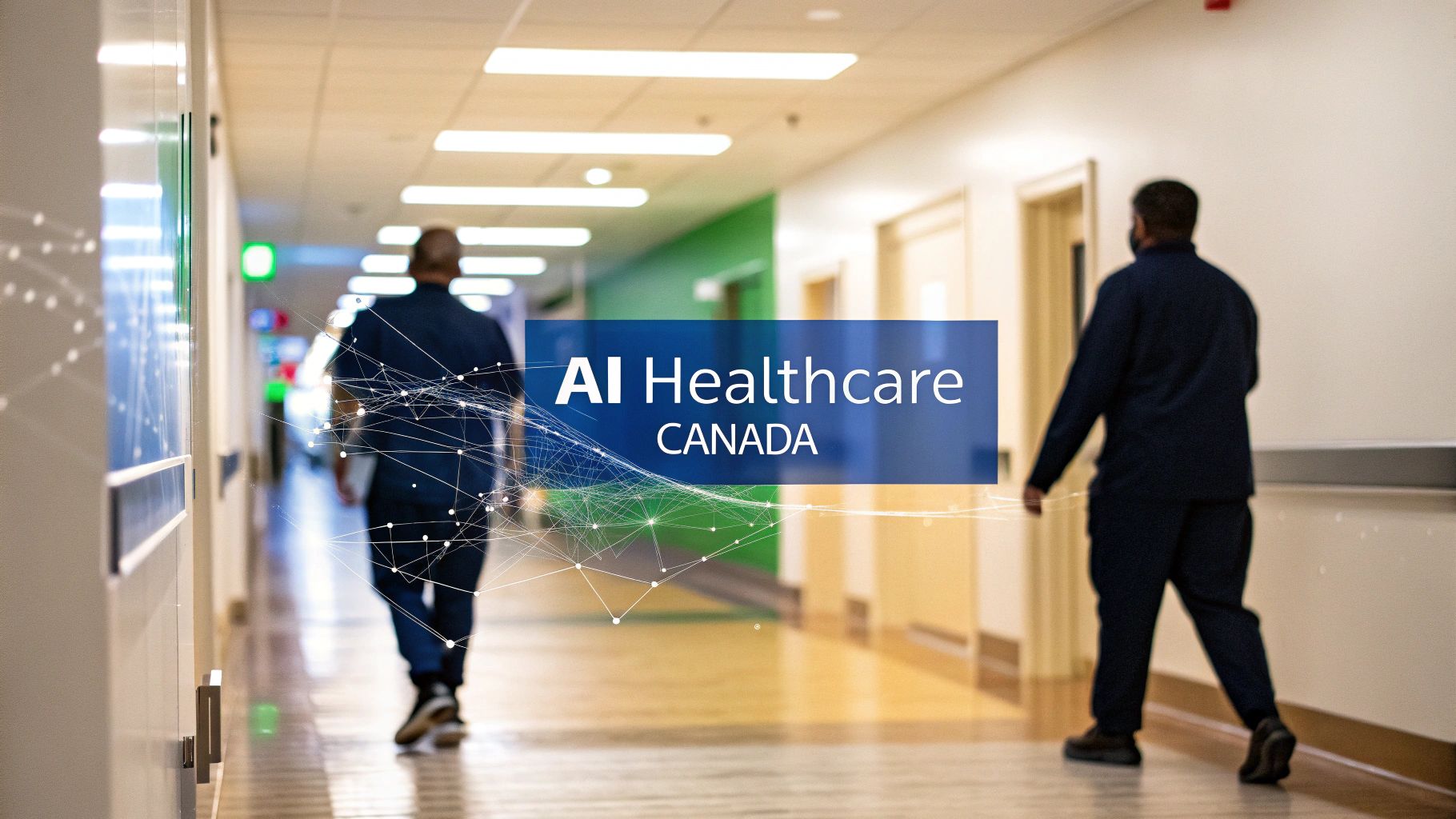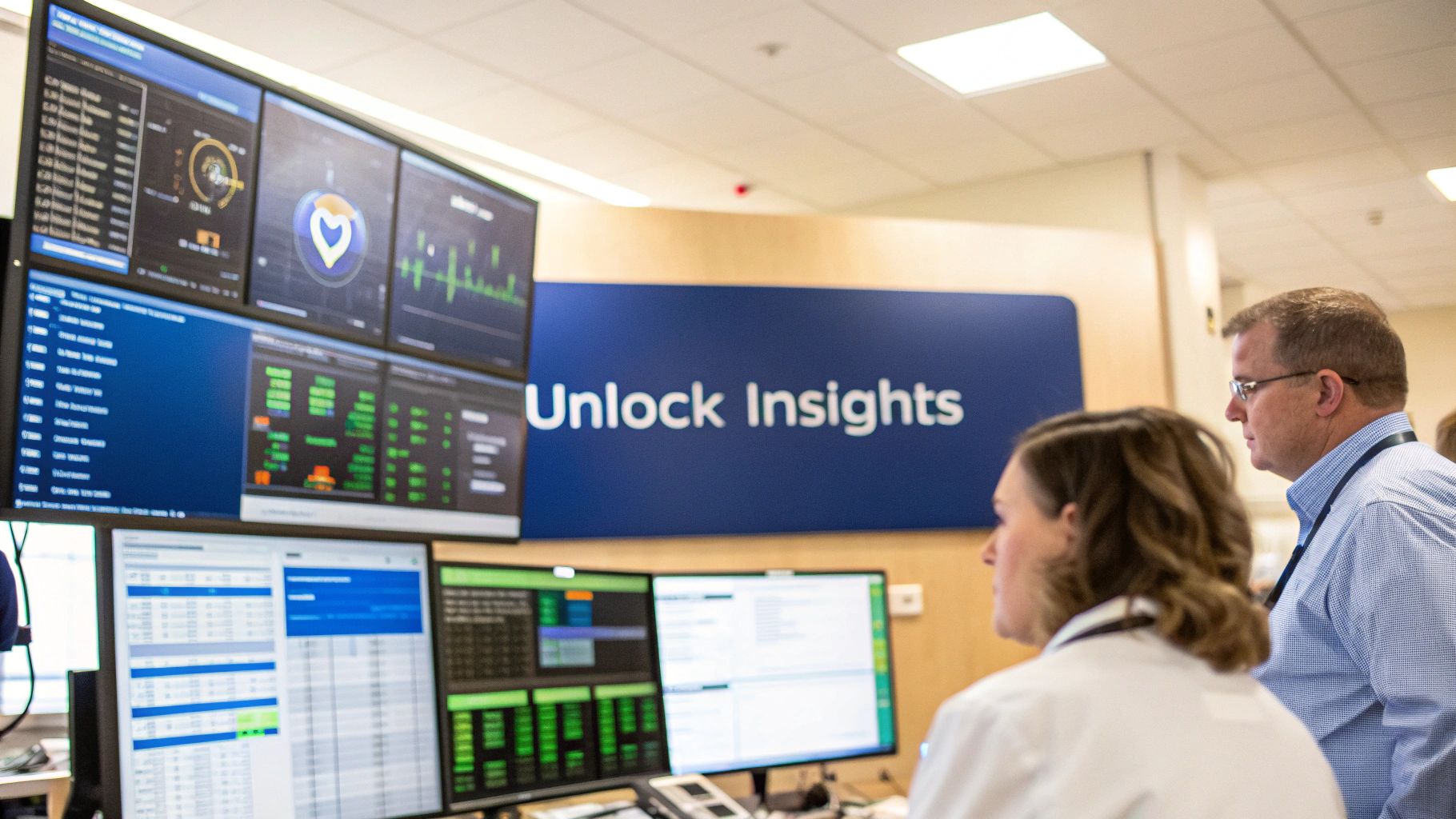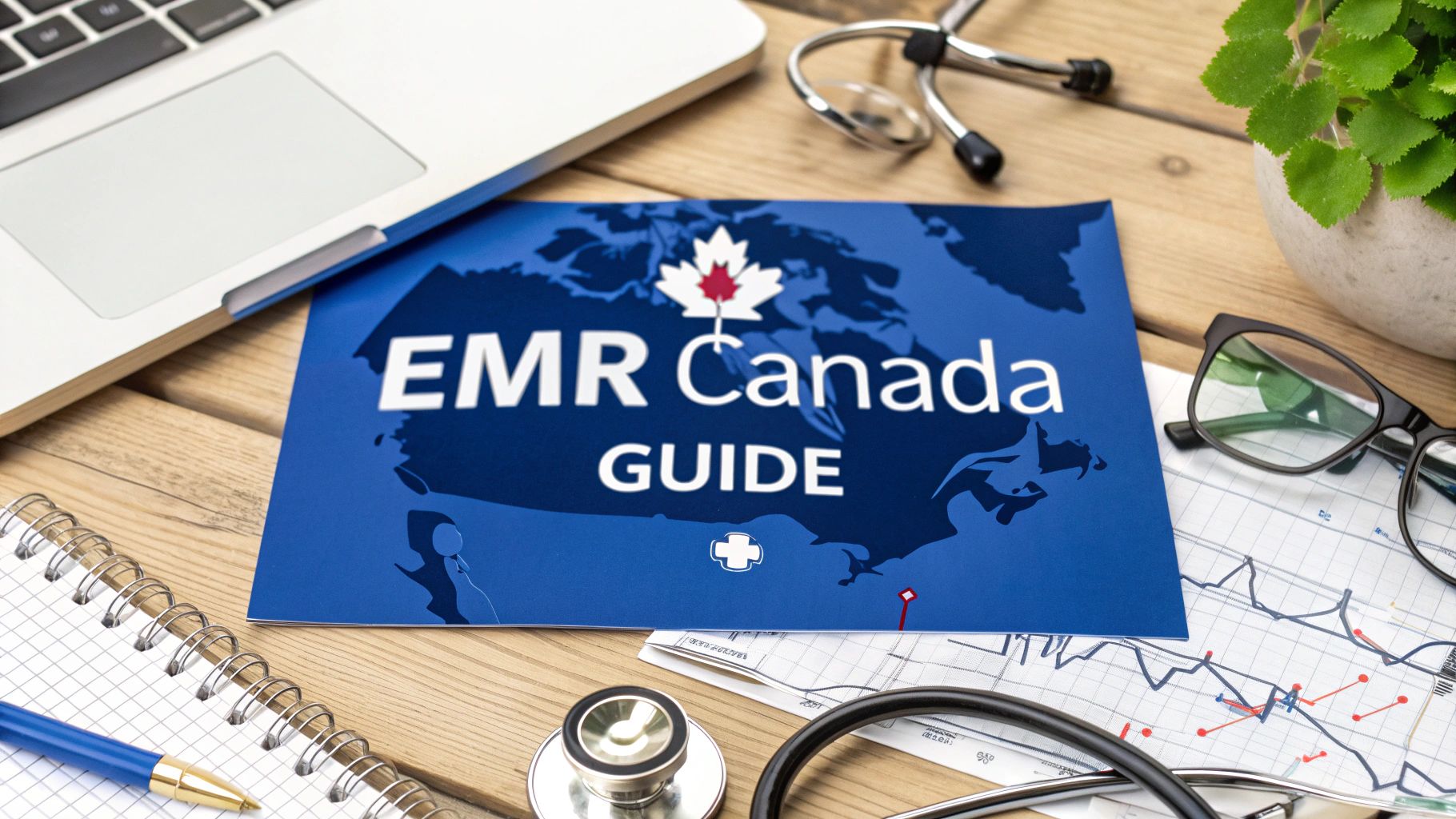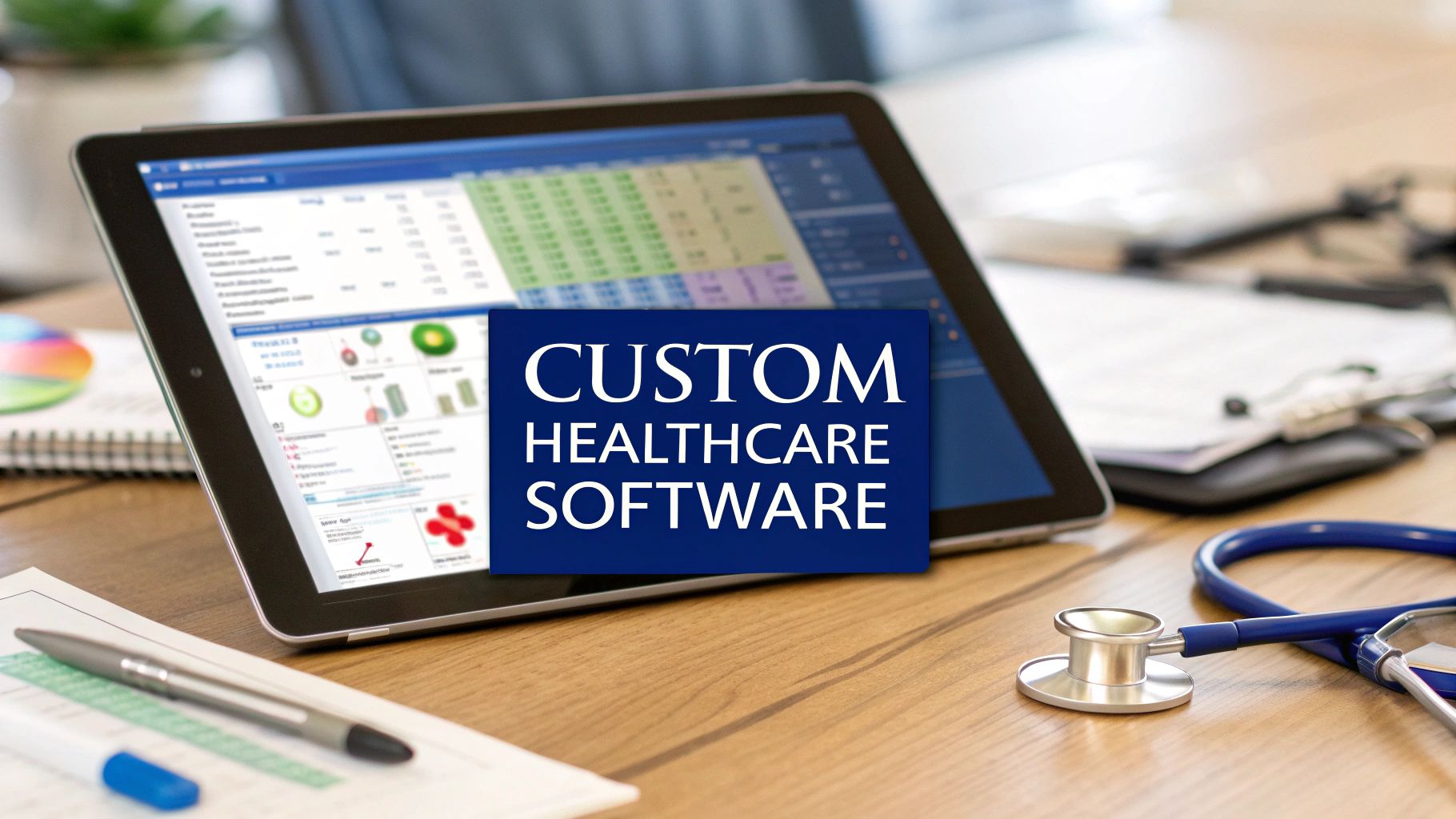The promise of AI in Canadian healthcare is pretty straightforward: delivering faster, more accurate diagnoses, slashing the administrative burden on clinicians, and ultimately building a more patient-centric system. This isn't just theory anymore; it's becoming a practical solution for some of the most stubborn challenges facing our healthcare system.
A New Era for Canadian Healthcare, Powered by AI
Picture a healthcare system that can predict a patient's needs before they become critical, give doctors insights that feel almost superhuman, and operate with remarkable efficiency. That's not a far-off dream; it's the reality that artificial intelligence is starting to create right here in Canada. From chipping away at long wait times to tailoring treatment plans for individual patients, AI is quickly becoming an essential tool.
The goal here has never been to replace human expertise; it’s about enhancing it. Think of it this way: AI algorithms can sift through medical images, flag patient risk factors, and manage hospital logistics at a speed and scale that’s simply beyond human capability. This frees up precious time for doctors, nurses, and other specialists to focus on what they do best: caring for people.
This visual breakdown shows just how significant AI's impact is already becoming.
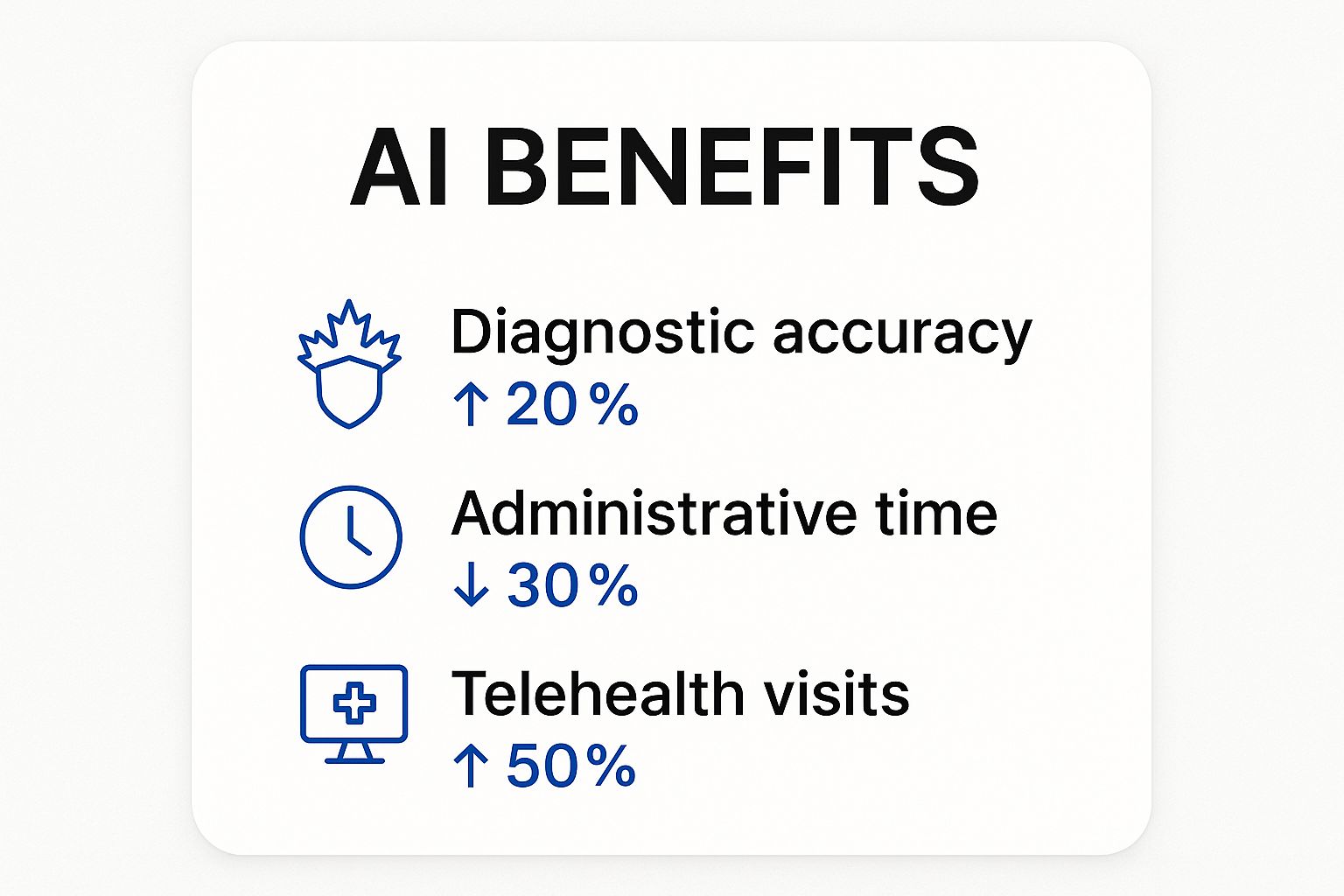
These numbers aren't just statistics; they represent a clear trend where AI is directly improving patient outcomes and making our hospitals run smarter.
To give you a clearer picture, this table breaks down how AI’s advantages ripple through the entire system, from individual patient experiences to the broader operational landscape.
Key Benefits of AI in Canadian Healthcare at a Glance
|
Area of Impact |
Benefit for Patients |
Benefit for Providers |
System-Wide Advantage |
|---|---|---|---|
|
Diagnostics |
Faster and more accurate disease detection (e.g., cancer, diabetic retinopathy). |
Decision support tools highlight potential issues in medical scans, reducing human error. |
Earlier intervention leads to better population health outcomes and lower long-term costs. |
|
Personalized Medicine |
Treatment plans tailored to their unique genetic and lifestyle factors. |
Access to data-driven insights for choosing the most effective therapies for an individual. |
Moves from a “one-size-fits-all” model to highly effective, individualized care. |
|
Administrative Tasks |
Shorter wait times for appointments and results as scheduling is optimized. |
Automation of repetitive tasks like charting and billing frees up time for patient interaction. |
Massive reduction in operational overhead and administrative waste. |
|
Resource Management |
More efficient hospital stays and better access to beds when needed. |
Predictive models for patient flow and staffing needs, preventing understaffing or overcrowding. |
A more resilient system that can better handle surges in demand, like a pandemic. |
As you can see, the benefits are interconnected. A clinician with less paperwork has more time for their patient, and a system that runs efficiently provides better, faster care for everyone.
Making Operations Smoother and More Affordable
Beyond the examination room, one of the most powerful arguments for AI is its economic sense. By taking over routine administrative chores and fine-tuning clinical workflows, AI drives significant efficiency. In fact, if adopted thoughtfully across the country, these technologies could potentially trim Canada's annual healthcare spending by up to CA$26 billion.
Artificial intelligence isn't just a tech upgrade. It's a complete rethink of how we deliver healthcare, making it more proactive, predictive, and personalized for every single Canadian.
Building a Stronger, More Resilient System
At the end of the day, bringing AI into healthcare is about creating a system that's more robust and responsive. The technology offers real answers to the systemic problems, like strained resources and unequal access to care, that have been a constant pressure point for years.
We're seeing major improvements in a few key areas:
-
Predictive Analytics: AI can help forecast disease outbreaks or manage hospital bed capacity to get ahead of overcrowding before it happens.
-
Personalized Medicine: It allows for treatments to be customized based on a person’s unique genetic makeup and lifestyle, leading to far better results.
-
Greater Accessibility: This technology is the engine behind telehealth platforms and remote monitoring tools that are finally bringing quality care to rural and underserved communities.
By tackling these core issues, AI is helping to build a system that is not only more efficient but also more equitable. To get a wider view of this shift, you can explore more on the overall impact of artificial intelligence in healthcare.
How AI is Helping Solve Canada's Toughest Healthcare Challenges

If you've ever dealt with Canada’s healthcare system, you’ve probably experienced some of its pain points firsthand. Think long waits for a specialist, or the headache of trying to coordinate medical records spread across different clinics and hospitals. These aren't just small annoyances; they affect patient outcomes and add a lot of stress for clinicians.
This is exactly where AI is starting to make a real difference. It’s not some magic cure-all, but a set of smart tools that can pinpoint and address these deep-rooted problems. Think of it as an analytical powerhouse that spots the bottlenecks and inefficiencies we can't easily see on our own.
Taming the Waitlist: AI and Smarter Scheduling
Waiting is one of the most common frustrations in healthcare. AI-driven predictive analytics offer a practical way to fix this. Picture an intelligent system that looks at years of data, patient no-shows, flu season spikes, and even a surgeon’s typical schedule to build a truly optimized hospital calendar.
This goes way beyond simple booking software. It’s about predicting demand before it hits and assigning resources where they’ll be needed most. By getting ahead of patient flow, hospitals can chip away at backlogs, shorten wait times for important procedures, and make sure that staff and operating rooms are always used effectively. The end goal? A smoother system that gets people the care they need, faster.
Unifying Patient Data for Safer, More Coordinated Care
Fragmented patient data is another huge obstacle. When your family doctor, a specialist, and the hospital pharmacist don't have the same information, care can become disjointed, and the risk of mistakes goes up. AI provides a way to finally connect the dots by creating a single, unified health record.
AI algorithms can securely gather information from different electronic health record (EHR) systems and organize it into one complete patient profile. This gives every clinician an immediate, clear view of a patient's entire medical history, allergies, and medications.
This cohesive approach helps eliminate redundant tests, flags potential drug interactions, and frees up clinicians from the time-consuming task of chasing down missing files. For patients, it means a safer and more streamlined journey through the healthcare system, because everyone on their care team is working from the same playbook.
The pressure this data chaos puts on our system is immense. A recent Philips Future Health Index found that 85% of Canadian healthcare professionals lose clinical time because of incomplete patient data, with almost half losing more than 45 minutes per shift.
On top of that, the report revealed that 45% of patients are stuck dealing with long waits for appointments, a delay that can have serious health consequences. By tackling these core challenges head-on, AI is helping to build a more responsive and reliable healthcare experience for all Canadians.
Sharpening Diagnostics and Personalizing Patient Care
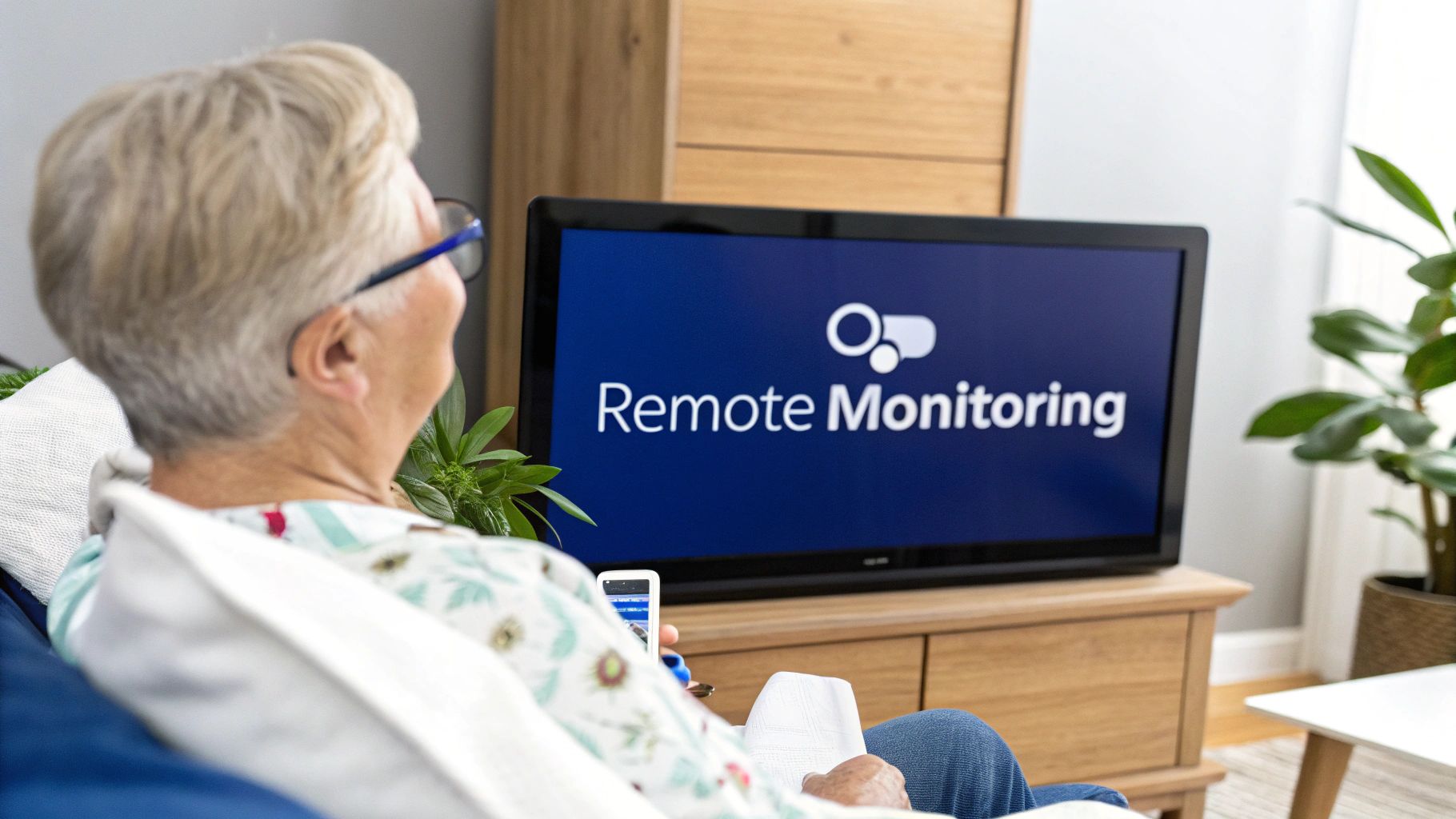
While making hospitals run smoothly is a huge win, the most significant impact of AI in Canadian healthcare is happening at the patient’s bedside. This is where the technology stops being an abstract idea and becomes a personal tool that fine-tunes diagnoses, anticipates health risks, and custom-builds treatments. It’s a major move away from one-size-fits-all medicine toward a future of genuinely precise, individualized care.
Think of an AI algorithm as a tireless specialist with an incredible eye for detail. It can comb through thousands of medical images, X-rays, MRIs, and CT scans in mere minutes, catching tiny anomalies the human eye might miss. This is a game-changer for early disease detection, especially in complex areas like oncology and radiology.
For example, AI models trained on massive libraries of mammograms can flag suspicious areas indicating breast cancer with astounding accuracy, often much earlier than a person could alone. This head start allows doctors to step in sooner, which can make a world of difference for a patient's outcome. The potential of AI-powered diagnostic assistant agents shows just how far we can push this accuracy, giving clinicians a powerful second set of eyes.
Moving Beyond One-Size-Fits-All Treatments
AI's capabilities don't stop at diagnostics; they're also reshaping how we plan treatments. Every patient is different, from their genetic code to their daily habits. So, why should their treatment be identical to someone else's? AI helps doctors answer that question by crunching huge amounts of data to craft care plans that are truly personal.
This process involves a few key steps:
-
Genomic Analysis: AI can scan a patient's genetic information to find markers that predict how they'll respond to specific medications.
-
Lifestyle Data Integration: By factoring in diet, exercise, and even environmental influences, AI helps create a complete picture of a person's health.
-
Predictive Modelling: Algorithms can forecast the likely progression of a disease in an individual, letting doctors get ahead of problems instead of just reacting to them.
AI doesn't just see a diagnosis; it sees the whole person. It uses data to build a rich health profile, helping doctors select the most effective and least invasive therapies from the start, cutting down on trial and error.
Take someone newly diagnosed with diabetes. An AI system could analyze their glucose monitoring data, eating habits, and genetic risk factors to recommend a hyper-specific management plan. This might include precise insulin dosing, customized meal suggestions, and even alerts for potential complications before they show up. This proactive approach is the essence of what we call predictive healthcare. You can learn more about this exciting field in our detailed guide on predictive healthcare with AI.
This degree of personalization not only leads to better health outcomes and fewer side effects but also gives patients a much deeper understanding of their own well-being. It’s one of the most promising applications of AI in Canadian healthcare, making medicine not just smarter, but more attuned to the individual.
Giving Clinicians Time Back to Focus on Patients
One of the most valuable things AI brings to Canadian healthcare isn't a flashy new diagnostic tool or a revolutionary treatment; it’s the gift of time. Doctors, nurses, and specialists across the country are drowning in administrative work. This mountain of paperwork pulls them away from what they’re meant to do: care for patients. It's also a massive driver of burnout.
This is where artificial intelligence comes in, acting as a smart digital assistant.
Picture a family doctor talking with a patient. In the background, an AI system is listening, understanding the medical conversation, and automatically drafting precise clinical notes. This isn't science fiction; this is the reality of AI scribes, and they’re already making a huge difference in clinics and hospitals.
These tools give clinicians back hours of their day, freeing them from tedious data entry. Instead of staring at a screen, they can make eye contact, listen closely, and build a genuine connection with the person in front of them. It’s about bringing the human element back to the forefront of medicine.
Easing the Administrative Burden
The paperwork burden on Canadian clinicians is immense, often eating up hours that would be better spent on patient care. AI-powered tools are designed to tackle exactly this problem by automating the repetitive, mind-numbing tasks that drain so much time and energy.
It goes well beyond just taking notes. AI can also help with:
-
Generating Referral Letters: Instantly creating detailed referral letters for specialists, pulling all the necessary information from the patient's file.
-
Summarizing Patient Histories: Turning a long, complex medical history into a clear, concise summary that a doctor can review in seconds.
-
Managing Electronic Health Records (EHR): Making it faster and easier to input and organize information within digital record systems.
This shift is a game-changer. When technology handles the administrative grunt work, healthcare professionals can dedicate their expertise to what really matters: solving complex medical problems and interacting directly with their patients. For a deeper look at this, our guide on AI-driven EHR solutions for modern healthcare explains how these systems are evolving.
Real-World Impact in Canadian Hospitals
This isn't just a theoretical idea. Pilot programs across Canada are demonstrating just how powerful these AI tools can be. On average, Canadian clinicians spend about 10 hours a week on documentation alone. AI scribes are changing that reality.
Take The Ottawa Hospital, for instance. After implementing an AI copilot tool, 70% of clinicians reported feeling less burned out. Even more impressive, the emergency department was able to see about two extra patients per physician each shift.
By automating documentation, AI is not just boosting efficiency, it's directly combating burnout and giving clinicians the breathing room they need to provide better, more compassionate care.
A pan-Canadian program studying these tools found that a staggering 94% of users reported significant time savings. The evidence is clear: this technology works.
Here's a closer look at the data from the pan-Canadian study, which shows just how much time is being reclaimed.
Impact of AI Scribe Technology on Clinician Time
|
Metric |
Findings from Pan-Canadian AI Scribe Program |
Real-World Impact |
|---|---|---|
|
Weekly Time Saved |
Clinicians saved an average of 3.4 hours per week. |
This translates to nearly half a day of administrative work eliminated every single week. |
|
Documentation Time Reduction |
Users reported a 50% reduction in time spent on clinical notes. |
Time spent typing notes after a patient visit is cut in half, allowing for faster turnaround. |
|
End-of-Day “Pajama Time” |
78% of clinicians reported spending less personal time on documentation. |
Doctors can finally leave their work at the office, significantly improving work-life balance. |
These numbers paint a clear picture. AI scribes are not just a minor convenience; they are fundamentally changing the day-to-day work of healthcare providers for the better.
To further chip away at administrative tasks, clinicians can also use tools like AI-powered voice typing in Microsoft Outlook. By thoughtfully integrating these technologies, our healthcare system can reduce friction and empower skilled professionals to focus on what they do best: caring for their patients.
Paving the Way for AI in Canadian Healthcare
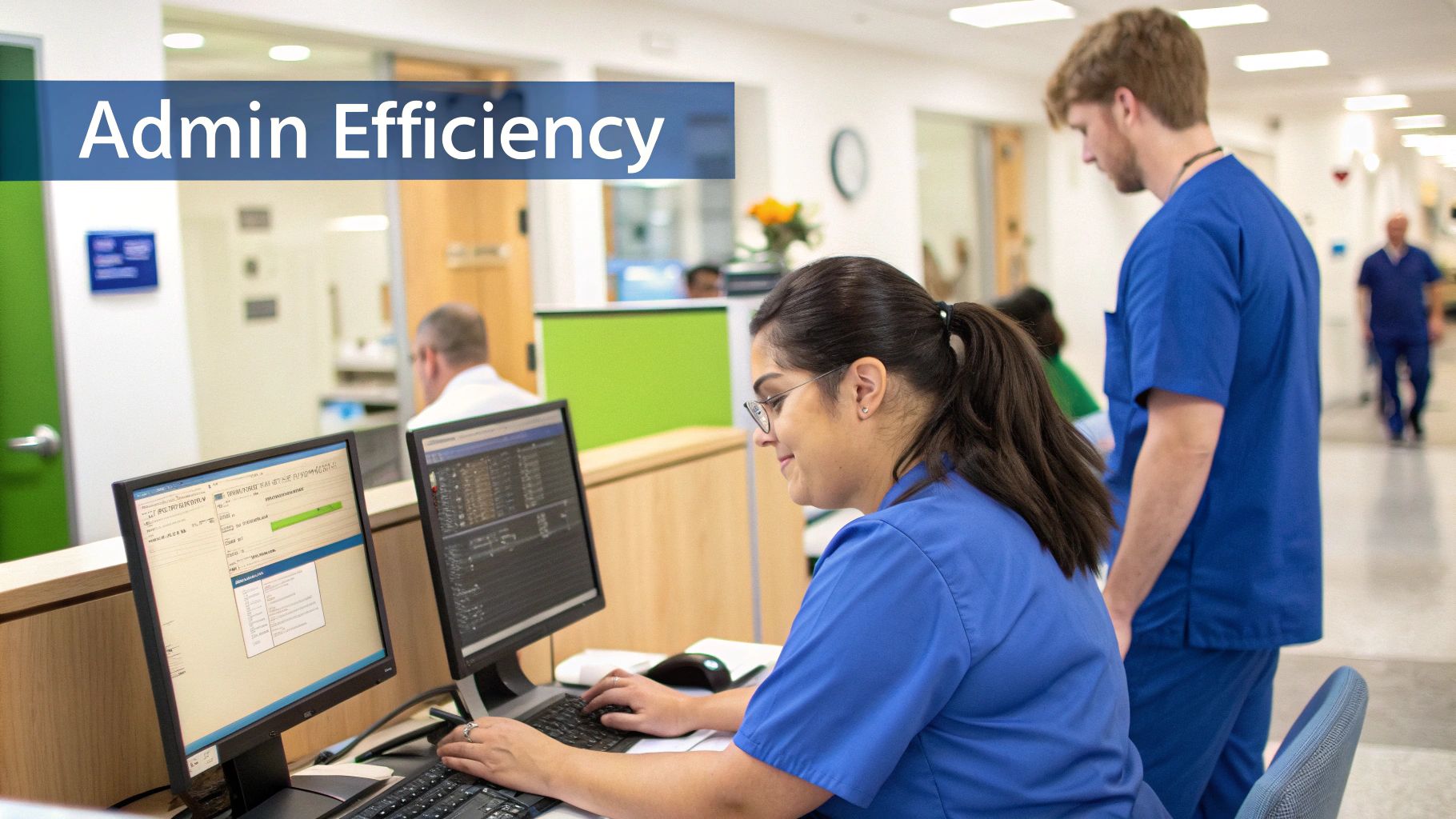
While the promise of AI in medicine is enormous, getting it right within Canada’s public healthcare system is no small feat. The path forward isn't a sprint; it’s a carefully planned journey. It demands a strategy that balances innovation with rock-solid caution, ensuring every step is secure, ethical, and built on a foundation of public trust. Powerful technology is one thing, but a clear and responsible plan to use it is what truly matters.
One of the biggest conversations revolves around data privacy. AI models, especially in healthcare, need huge amounts of health information to learn and become effective. This immediately raises a critical question: how do we protect that deeply personal data? We need ironclad rules and systems that safeguard patient confidentiality without exception, meeting Canada’s strict privacy laws and giving people total confidence that their information is safe.
Then there's the challenge of getting everyone on the same page. Without a consistent set of rules, progress can be chaotic and uneven.
We Need Clear Ethical Guardrails
To truly unlock AI's potential in our healthcare system, we need a unified ethical framework. This means tackling some tough questions head-on. How do we make sure an AI tool doesn't accidentally amplify existing biases in healthcare? If a diagnostic algorithm makes a mistake, who is ultimately accountable?
Figuring this out is a team sport. It requires bringing a wide range of voices to the table to build a system that works for everyone.
-
Government Bodies: Their job is to set clear, enforceable regulations that protect all Canadians.
-
Healthcare Providers: We need their practical, front-line insights to know what actually works in a clinic or hospital.
-
Technology Innovators: They have to build AI tools that are transparent and ethically designed from the ground up.
-
Patient Advocacy Groups: They ensure the patient's voice and concerns are always at the centre of the conversation.
A successful AI strategy in healthcare isn't just about code and algorithms. It's about building a system that is fundamentally fair, transparent, and accountable to the people it serves.
Getting Systems to Talk to Each Other
Canada’s healthcare system is managed province by province, which creates a classic Canadian challenge: interoperability. In simple terms, systems need to be able to talk to each other. For AI to work its magic, a patient’s health records from a clinic in Alberta must be instantly and securely available to a specialist in an Ontario hospital if the need arises.
Right now, that's often not the case. Achieving this kind of seamless communication requires standardized data formats and shared technical protocols across the entire country. Think of it as creating a common digital language that all provincial health systems can speak.
Without this "digital handshake" between provinces, AI’s impact will always be siloed and limited. The ultimate goal is a truly connected healthcare ecosystem where critical information flows freely yet securely, no matter where a patient is. By tackling these challenges with purpose, Canada can build an AI-powered healthcare system that isn't just technologically advanced but also equitable and trustworthy for all.
Here’s the rewritten section, designed to sound like it was written by a human expert in the field.
What AI in Healthcare Really Means for You
We're starting to see artificial intelligence move out of the lab and into our daily lives, and for Canadians, the healthcare system is one of the most promising frontiers. This isn't science fiction with robot doctors; think of it as giving our dedicated healthcare professionals smarter, more supportive tools. The goal is to build a more precise system, runs more smoothly and, most importantly, is centred around you, the patient.
What does that look like in practice? It could mean getting your diagnostic results back faster, receiving a treatment plan that's fine-tuned specifically for you, or simply having a doctor who has more time to listen because administrative busywork is handled automatically. All across the country, AI is quietly starting to raise the bar for quality care.
But getting this right involves more than just plugging in new technology. It’s a group effort.
Building a Smarter, Healthier Future Together
For an AI-powered healthcare system to truly work, it can't just be about brilliant software. It needs a shared commitment from everyone to steer its growth with a steady hand and a clear sense of purpose.
This means we need open and honest conversations between patients, doctors, government leaders, and the tech experts building these tools. These discussions are essential to make sure AI is used ethically and that it benefits everyone, not just a select few. It also takes smart investments, both public and private, to give our hospitals and clinics the support they need to bring these advancements on board responsibly.
Ultimately, weaving AI into our healthcare system isn't just a technical problem to solve; it's a human one. It’s about building a future where technology gives more power to both patients and the people who care for them.
By moving forward with a clear vision and strong ethical guidelines, every single Canadian has a part to play. We're all in this together, shaping a healthcare system that’s more responsive and effective for generations to come.
Frequently Asked Questions About AI in Canadian Healthcare
It’s completely understandable to have questions as technology and medicine come closer together. When we talk about artificial intelligence in our healthcare system, it’s natural to wonder what that really means for your privacy, your treatment, and your next visit to the doctor.
This section tackles some of the most common questions we hear, with clear, straightforward answers. The goal is to cut through the noise, address real concerns, and show how this technology can build a better, more efficient healthcare system for everyone in Canada.
How Is My Personal Health Information Kept Safe?
Protecting your privacy is the cornerstone of healthcare, and that doesn't change with AI. In fact, the rules are just as strict. Any AI tool used in Canadian healthcare has to follow stringent federal and provincial privacy laws, like the Personal Information Protection and Electronic Documents Act (PIPEDA).
To make this happen, patient data is typically anonymized or de-identified before it's used to teach an AI model. This process strips away any personal details, like your name or health card number, so the system can learn from the medical information itself without ever knowing who it belongs to.
On top of that, these systems are built with serious cybersecurity measures, tight access controls for authorized staff, and are regularly audited. It's a multi-layered defence designed to ensure that AI is used safely and ethically, fully in line with Canada's high standards.
Will an AI Make the Final Call on My Treatment?
Absolutely not. Think of AI as a highly skilled assistant for your doctor, not a replacement. The final decision about your diagnosis, treatment, or care plan will always rest with a qualified healthcare professional.
An AI algorithm might, for instance, analyze a medical scan and flag potential areas of concern for a radiologist to look at more closely. Or it might sift through massive amounts of clinical research to suggest a few treatment options that have worked for patients with a similar profile.
The AI provides data-driven insights and highlights information, but it's your doctor who puts it all into context. They use their expertise and judgment to make the best, most informed choice for your specific situation. The human expert is always in charge.
When Will I Actually See AI at My Doctor's Office?
Chances are, you already have; you just might not have noticed it. Many Canadian hospitals and clinics are already using AI behind the scenes to make things run more smoothly.
You'll find it in applications like:
-
Smarter Appointment Scheduling: AI can look at booking patterns to help reduce wait times and make sure the clinic isn't overbooked.
-
Automated Clinical Notes: Some systems can listen to a conversation between a doctor and patient and automatically create accurate medical notes, giving the doctor more time to focus on you.
-
Managing Hospital Resources: AI can help predict how many patients might be admitted, ensuring there are enough beds and staff ready to go.
More direct uses, like in diagnostics or personalized medicine, are being rolled out carefully across the country. The pace might differ from province to province or even hospital to hospital, but integrating these tools is a major focus for modernizing Canadian healthcare and improving patient outcomes.
At Cleffex Digital Ltd, we specialize in developing secure, compliant, and AI-driven solutions that address the unique challenges of the healthcare sector. Our custom software helps clinics, hospitals, and life sciences startups harness the power of technology to improve patient care and optimize operations. Discover how our innovative approach can support your organization by visiting us at https://www.cleffex.com.



